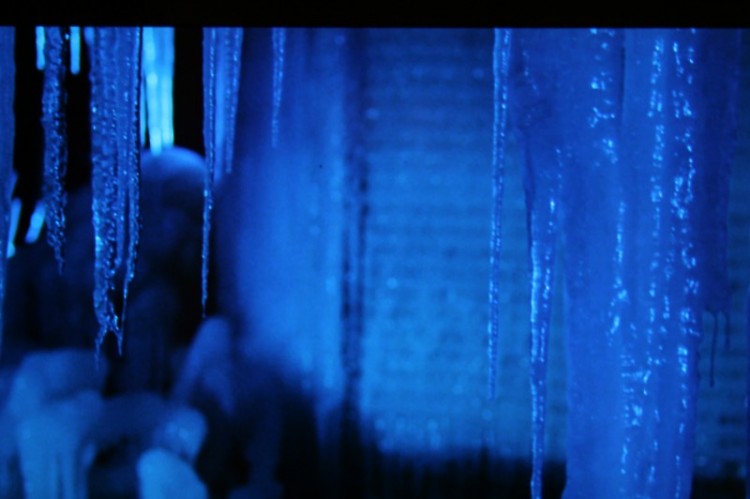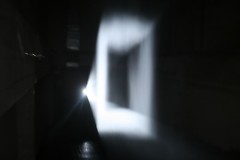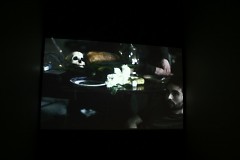I was sorry to see that the ArtPrize top ten did not include a single example of photography, film, or video art. I was not surprised to see the continued preference for conventional “art” materials and processes by the majority of ArtPrize voters with the exception of Beili Liu’s stunning installation Lure Forest. Of the 70 video and film art submissions, only two were voted into the top 100: Alex Schweder La's Evaporative Buildings (top 100) and Gregory Holm and Matthew Radune with Icehouse Detroit (top 75).
I speculate that photography, film, and video were notably absent from the top 10, even the top 100 because of their ubiquity in everyday contemporary culture. Photographic imagery (especially the moving picture) is so familiar to us in this digital age, in every setting from smartphones to video games to YouTube, that it is less vote-worthy when it comes to a major art competition than wood carving, mosaic and photo-realist drawing.
Unfortunately, this is a case in which viewers are too familiar with the medium to recognize its complexity, overlooking a central issue in contemporary art practice: The relationship between material and concept, or that, as the mass media scholar Marshall McLuhan famously stated, “the medium is the message.”
I’ll choose as my example the image awarded the top prize, Chris Laporte’s, Cavalry, American Officers, 1921. There is no doubt that the monumental drawing is a tour de force of contemporary draughtsmanship and naturalism. However, the image’s popularity causes me to consider the underlying implications of its appeal. The United States is currently involved in wars with dire global implications, employing technologies and resources that sound more like science fiction than real life to most outside the military. Why are viewers so satisfied by Laporte’s ennobling concept of war from nearly a century ago (1921), rendered in the visual language of the Renaissance? Is drawing the most authentic medium to address the nature of military experience in the twenty-first century, or are we simply unwilling to look at the issue of military engagement and service in the language of our own time?
Video is, of course, hardly a new medium in art. In the 1960s, one of its pioneers, Nam June Paik, observed that the cathode ray tube would replace the canvas. Last week’s voting results however suggest that a more conventional definition of art materials persists for the general population. Paik’s earliest video works, like TV Garden (1974), were television installations both playful and meditative that called attention to its increasing prevalence in modern life while exploring the malleability of video/moving picture images, laser, projection, and other dimensions of video practice. Paik was still working and exhibiting as late as 2004. When he died in 2006 he left an inspiring legacy of the exploration of the transformative aesthetic and political possibilities of television and video.
Technological changes since the 1960s have transformed film/video practice. In the late 1990s,film and video art became what performance was to the 1970s, the dominant avant-garde form. Galleries were filled with multiple screen projections, and the medium emerged as an amalgam of sculpture, architecture, performance and moving picture imagery. An example can be found in Alex Schweder La’s, Evaporative Buildings, displayed at the UICA. The work involved the projection of a structure into a mechanically produced mist. The nature of Schweder’s work is rooted in process. Unlike many of the works of art we have seen in ArtPrize, the work is not a tangible object.
Process art and video often overlap in that both have participated in the dematerialization of art; art becomes a series of impressions and sensations that engage the viewer but reject the physical boundaries and fixed presence of paintings, sculptures, and architecture. Such a time- and space-bound presence allows video and process artists to comment on the nature of our passing existence in a way that fixed objects can never capture. That Schweder uses such an ephemeral approach to address something as presumably monumental as architecture gives his practice unique relevance in the United States at the moment. In the face of the unemployment and foreclosure crises in Michigan, what has become more elusive, more transient, lately, than our very homes? I cannot imagine an image that speaks with more heartrending insight to the architectural experience in our Michigan neighborhoods of late than Evaporative Buildings.
The housing crisis is even more directly addressed in Holm's and Rathune's Icehouse Detroit, shown at the Women's City Club. The project incorporated a process-based performance in which an abandoned house was encased in ice. Holm and Rathune's Artprize statement speaks to the relationship between the medium of film and the phenomenon of transformation: "While the installation began as a purely aesthetic pursuit it quickly morphed into a beacon for social change and dialogue. The project brought together local citizens, non-profit groups, and government organizations as supporters and stakeholders. The artists' belief is that art can help to create an environment in Detroit, and places with similar challenges, that promotes civic pride and a new economy." The film includes none of the direct messages associated with documentary, yet it records with a vision both incisive and poetic the aching losses in this once vital city.
Video art is not only a medium to be valued for its political and social relevance. Goldstein's The Jettisoned, winner of the Time-Based Award, has the rich color, texture, and symbolic complexity of 19th century history painting, complete with still life and memento mori fragments. Goldstein's balance of stillness and motion gives it a monumental pace that picks up where the fixed boundaries of painting have left off.
Although the form of video requires a time investment by the viewer often this investment is far less than most of us are willing to give to watching a television program or feature film. I hope that the examples I've discussed here further illustrate that the investment pays off in the transformative process the viewer is introduced to. One of my favorite cultural critics, bell hooks, suggests that art has an impact on us through two factors: “recognition of the familiar—that is, we see in art something that resembles what we know—and second, that we look with the received understanding that art is necessarily a terrain of defamiliarization: it may take what we see/know and make us look at it in a new way.”
As a work of photography, film, and video art moves you from a position of familiar recognition of the medium, to a defamiliarization in which our expectations and assumptions are unsettled, we are moved to understand our environment and our visual field in new ways. Is there any better outcome to ask from art?
The Rapidian, a program of the 501(c)3 nonprofit Community Media Center, relies on the community’s support to help cover the cost of training reporters and publishing content.
We need your help.
If each of our readers and content creators who values this community platform help support its creation and maintenance, The Rapidian can continue to educate and facilitate a conversation around issues for years to come.
Please support The Rapidian and make a contribution today.




Comments
I agree with this one. TRANSPLANT at the FountainSt Church was an incredible piece of video sculpture...and with a serious message too...